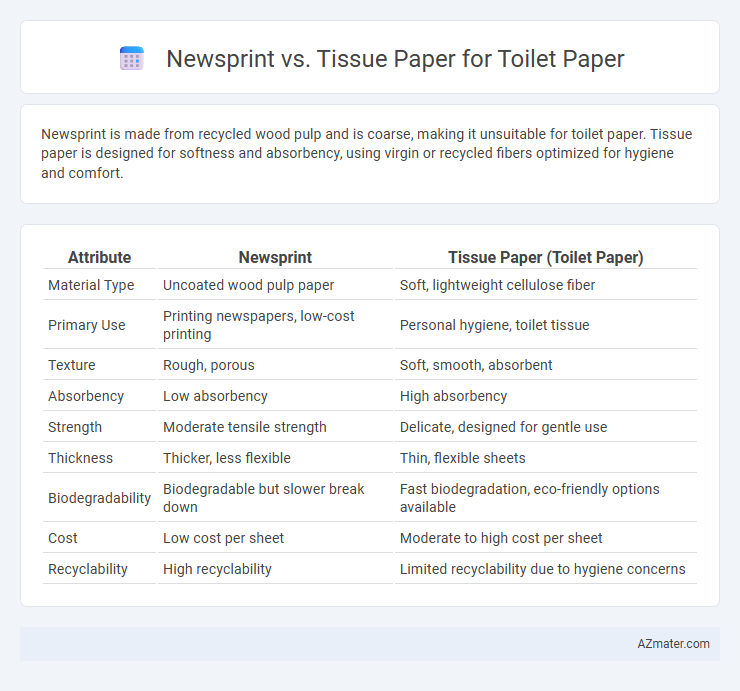Newsprint is made from recycled wood pulp and is coarse, making it unsuitable for toilet paper. Tissue paper is designed for softness and absorbency, using virgin or recycled fibers optimized for hygiene and comfort.
Table of Comparison
| Attribute | Newsprint | Tissue Paper (Toilet Paper) |
|---|---|---|
| Material Type | Uncoated wood pulp paper | Soft, lightweight cellulose fiber |
| Primary Use | Printing newspapers, low-cost printing | Personal hygiene, toilet tissue |
| Texture | Rough, porous | Soft, smooth, absorbent |
| Absorbency | Low absorbency | High absorbency |
| Strength | Moderate tensile strength | Delicate, designed for gentle use |
| Thickness | Thicker, less flexible | Thin, flexible sheets |
| Biodegradability | Biodegradable but slower break down | Fast biodegradation, eco-friendly options available |
| Cost | Low cost per sheet | Moderate to high cost per sheet |
| Recyclability | High recyclability | Limited recyclability due to hygiene concerns |
Introduction to Toilet Paper Materials
Toilet paper primarily consists of two types of materials: newsprint and tissue paper, each offering distinct textures and absorbency levels. Newsprint, made from recycled newspaper fibers, tends to be rougher and less absorbent, while tissue paper is manufactured from virgin or recycled softwood fibers designed specifically for softness and strength. The choice between these materials impacts comfort, environmental sustainability, and cost-effectiveness in toilet paper production.
What Is Newsprint Paper?
Newsprint paper is a low-cost, lightweight paper primarily used for printing newspapers, made from wood pulp with minimal processing and a rough texture. Unlike tissue paper, newsprint lacks softness and absorbency, making it unsuitable for toilet paper use where comfort and hygiene are essential. Its composition and porous structure prevent it from meeting the sanitary and strength requirements necessary for personal hygiene products.
What Is Tissue Paper?
Tissue paper is a lightweight, soft, and absorbent paper specifically designed for personal hygiene uses, including toilet paper, facial tissues, and napkins. Unlike newsprint, which is coarser and made from recycled paper primarily used for printing and packaging, tissue paper is manufactured from virgin or recycled pulp that ensures softness, strength, and comfort. Its structure often includes multiple thin layers or plies to enhance absorbency and durability during use.
Manufacturing Process Comparison
Newsprint and tissue paper differ significantly in their manufacturing processes, with newsprint primarily produced using mechanical pulping that preserves wood fibers but results in lower softness and absorbency. Tissue paper undergoes chemical pulping and extensive refining to enhance fiber softness, strength, and absorbency, essential qualities for toilet paper performance. The production of tissue paper also involves controlled drying techniques and creping to improve texture and flexibility, which are not part of the newsprint manufacturing process.
Softness and User Comfort
Newsprint is significantly rougher and less absorbent compared to tissue paper, making it unsuitable for toilet paper use when softness and user comfort are priorities. Tissue paper is specially designed with fine fibers and a cushioning texture that enhances softness and reduces irritation during use. Consumer preference strongly favors tissue paper for its gentle feel and superior comfort, which is essential for daily hygiene.
Strength and Durability
Newsprint fibers are generally coarser and less absorbent, resulting in lower strength and durability compared to tissue paper specifically designed for toilet use. Tissue paper incorporates softer, more refined fibers and often includes additives to enhance tensile strength and resistance to disintegration when wet. This makes tissue paper significantly more durable and comfortable, ensuring effectiveness during use without tearing or falling apart.
Environmental Impact and Sustainability
Newsprint used in toilet paper production often involves recycling of printed paper, reducing waste but potentially containing ink residues and chemicals that may affect biodegradability and recycling efficiency. Tissue paper is typically made from virgin or recycled fibers specifically processed for softness and rapid decomposition, offering a more sustainable option when sourced from responsibly managed forests or certified recycled content. Choosing tissue paper with eco-labels like FSC or Green Seal supports environmental sustainability by minimizing deforestation, chemical use, and carbon footprint compared to traditional newsprint-based alternatives.
Cost and Availability
Newsprint is significantly cheaper than tissue paper due to its abundance and lower production costs, making it a budget-friendly option for toilet paper manufacturing. However, newsprint's availability fluctuates with print media demand, whereas tissue paper is consistently produced in large quantities for hygiene products and remains widely accessible. Cost efficiency is a critical factor, but tissue paper's softness and absorbency make it preferable despite slightly higher prices and steady market availability.
Health and Safety Concerns
Newsprint paper contains inks and chemicals that can cause skin irritation and pose health risks when used as toilet paper. Tissue paper designed for hygiene is manufactured to be soft, hypoallergenic, and free from harmful substances, minimizing the risk of infection or allergic reactions. Using newsprint instead of tissue paper can lead to bacterial contamination and increased susceptibility to urinary or gastrointestinal infections due to its rough texture and chemical residues.
Final Verdict: Newsprint vs Tissue Paper for Toilets
Tissue paper is specifically engineered for softness, rapid disintegration, and minimal clogging, making it the optimal choice for toilet use compared to newsprint. Newsprint, while cost-effective and durable for printing, lacks biodegradability and softness, increasing the risk of plumbing issues. The final verdict favors tissue paper for toilets due to its superior comfort, safety, and environmental benefits.

Infographic: Newsprint vs Tissue Paper for Toilet Paper
 azmater.com
azmater.com